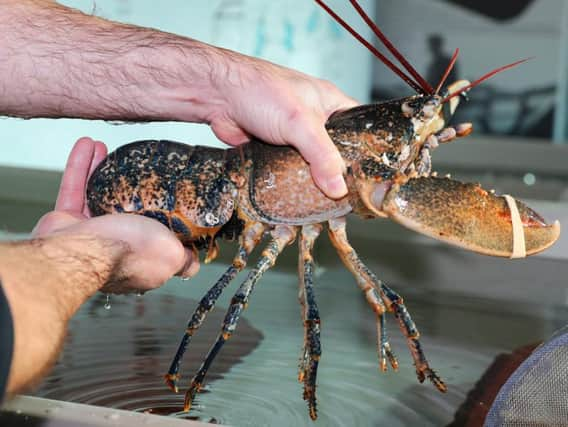Pricey Yorkshire coastal cannibals were once preserve of the poor - Roger Ratcliffe


We rounded the west pier and headed up the coast, and by the time we were checking the first pot off the grey cliffs of Kettle Ness and Runswick Bay the North Sea was turning as deep a shade of pink as, well... a cooked lobster.
Advertisement
Hide AdAdvertisement
Hide AdThe pots, or creels, were fixed to buoys and each one had a marker flag bobbing in the slight swell.
One by one, the nylon ropes attached to the pots were caught by pole hooks then pulled onto the port side of the boat, fed between the wheels of a hauling motor which raised the pots to the surface.
Some pots contained more than half a dozen of the shiny bluish black crustaceans with rust-coloured claws, others had trapped just a few. Those that were shorter than the legal minimum size of 87mm were returned to the sea.
Each pot was rebaited with dead fish heads - the smell was almost asphyxiating - before being lowered back to the sea floor.
Advertisement
Hide AdAdvertisement
Hide AdThe reason for the dead fish bait is that lobsters move too slowly to capture food on the rocky coasts they inhabit and so are scavengers feeding on the carrion of the rock coast, like red kites of the sea.
They are also notoriously cannibalistic, which is why they have tight rubber bands placed on their claws the moment they are caught. Without them they would devour each other and probably leave just a pile of shells.
The lobster harvest eventually tallied more than 50, and given that an average lobster weighing one kilo might fetch up to £12 it represented a good morning’s work.
Advertisement
Hide AdAdvertisement
Hide AdSome days, I was told, the potters could bring more than 100 lobsters back to Whitby. Down in Bridlington, the catches are even bigger and a few years back the resort was named the lobster capital of Europe.
Paradoxically, lobster is not a common menu item in many restaurants along the Yorkshire coast because of its high price, which is largely driven by fishermen being unable to satisfy the high demand for lobsters.
An exception to the steep price is one cafe in Whitby that sells lobster thermidor and chips for not much more than its king-sized haddock.
Advertisement
Hide AdAdvertisement
Hide AdBut in Harrogate, where disposable income is higher, I have seen Yorkshire-sourced lobster dishes costing upwards of £25 a time.
Much of our lobster catch ends up on continental dinner plates, especially those in France and Spain. Meanwhile, budget supermarkets have begun to import frozen lobsters from the north-west USA and even south-east Asia, and they typically cost half the price of a Yorkshire lobster.
Long ago lobsters were not seen as a luxury food. After the Pilgrim Fathers, who set out from Killingholme Creek on the Humber, arrived on the North American coast in 1620, they found lobsters to be so abundant that they were considered fit only for the tables of the poor.